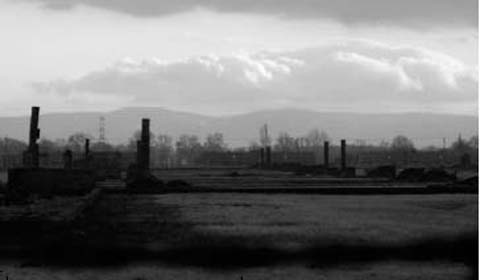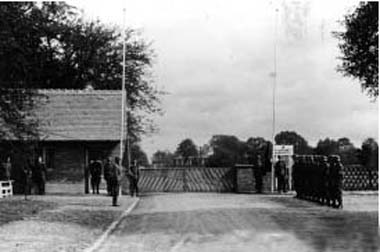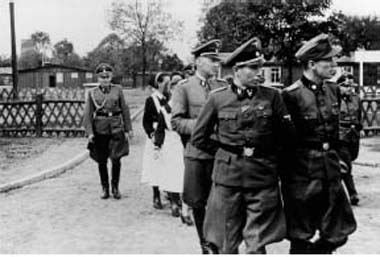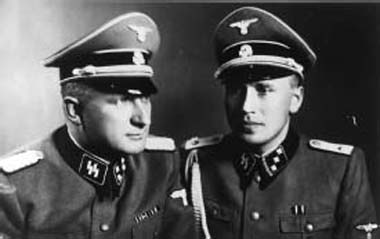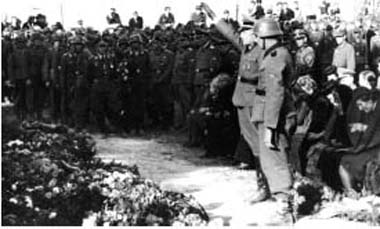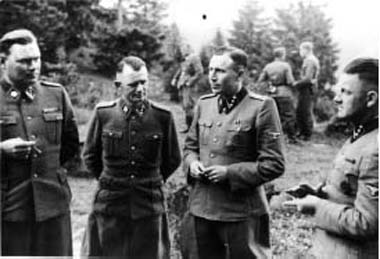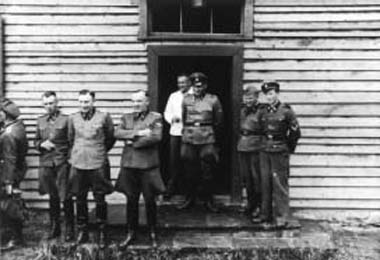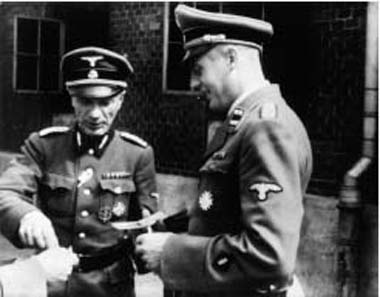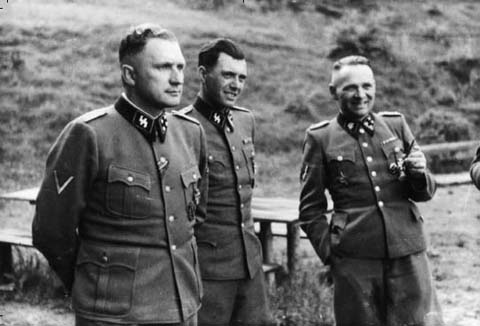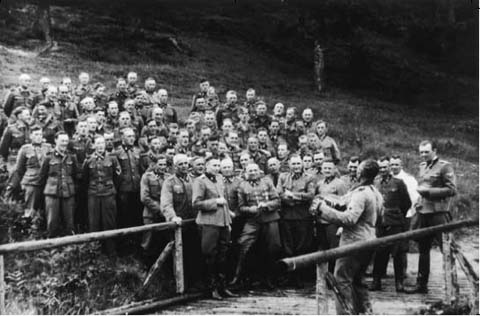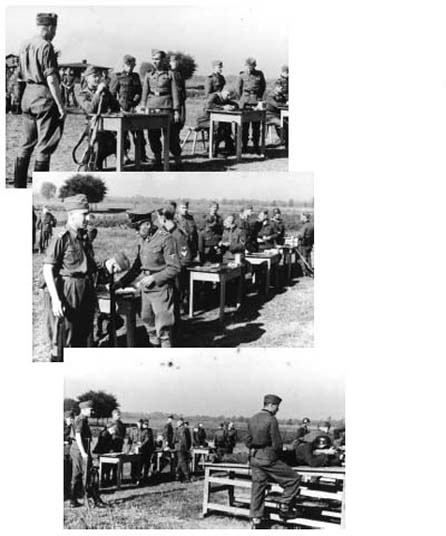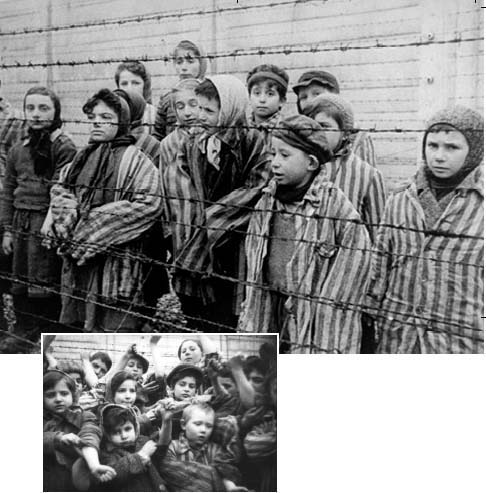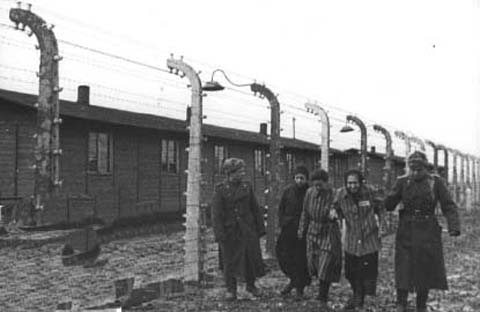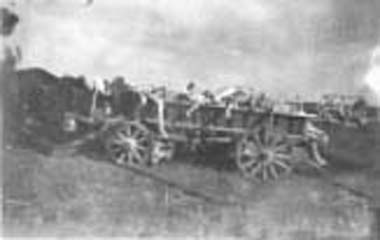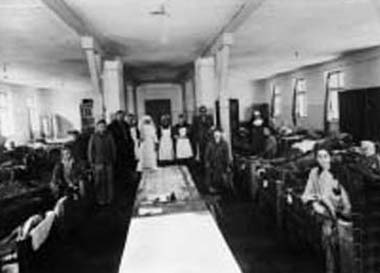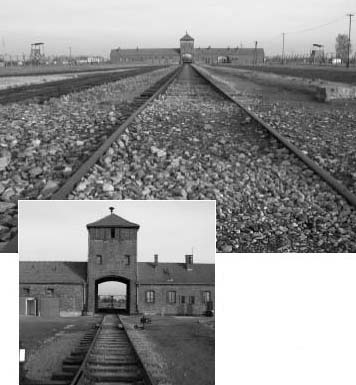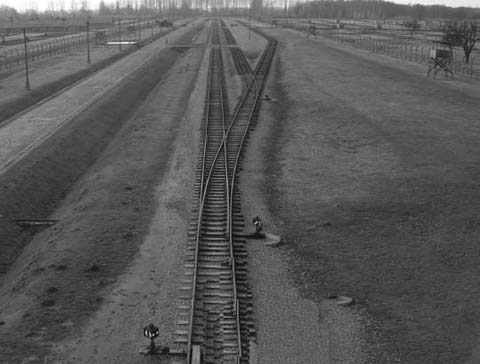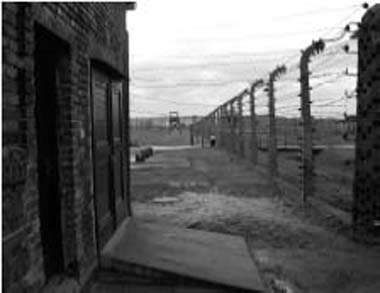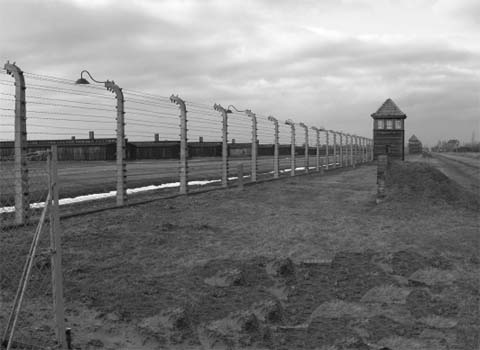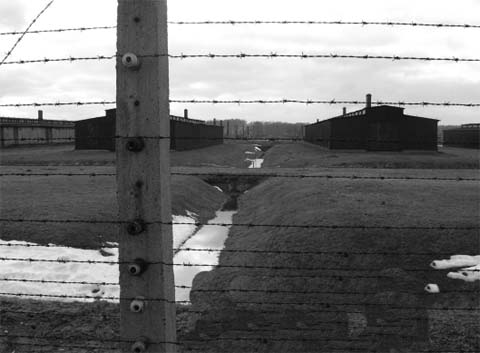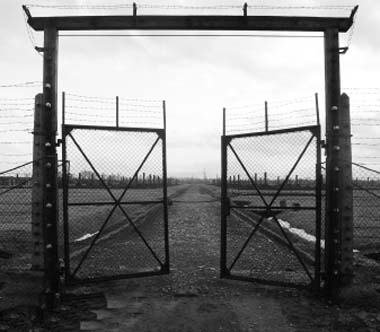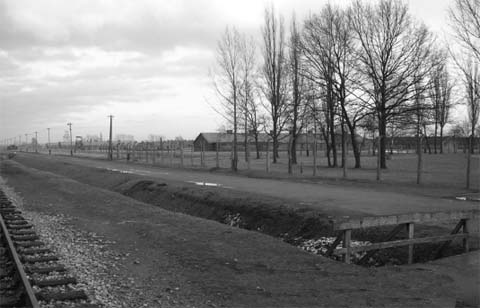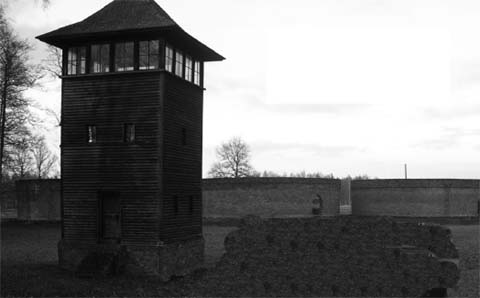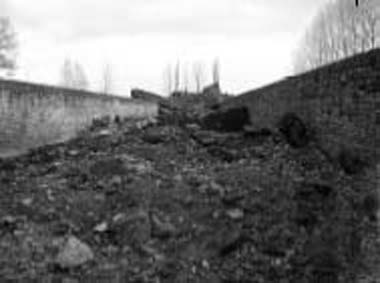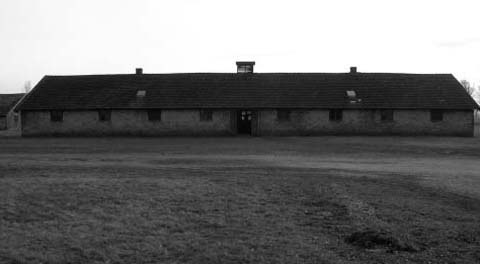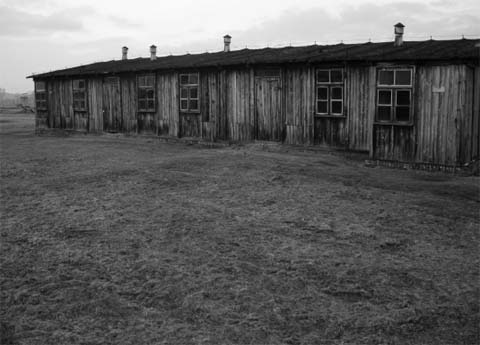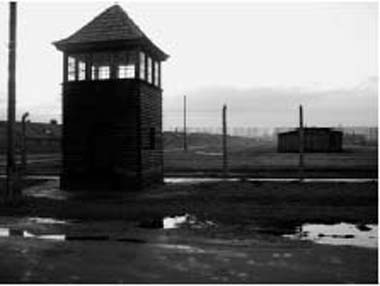The End
By 1944, with death camps like Kulmhof, Sobibor, Belzec, and Treblinka now closed down, it was up to the other camps, in particular Auschwitz-Birkenau, to take responsibility for the remnants of the Jewish communities of Poland, France, the Netherlands, Italy and the rest of occupied Europe. Hungary was one particular country that still had the largest amount of Jews. Almost 725,000 Jews were still on Hungarian territory, and for the German government that figure was too much an opportunity to resist.When the German occupation forces rolled across into Hungary on 19 March, Himmler now wanted the Hungarian Jews transported to Auschwitz where they would be selected for slave labour and shipped out again through the various concentration camps that served the German industry. Those that were selected for labour would be held in quarantine until transport was made readily available to them. In effect, the Reichsführer was planning to turn Auschwitz into a huge labour exchange, just as he had done with the main camp in 1940. But now it was on a greater scale than ever before. The Auschwitz authorities were informed that they were to prepare for a huge assignment of Hungarian Jews. They were also told that more of an effort was to be made to separate those Jews who could serve the German war effort through work, but were to continue to use ‘special treatment’ on those that served absolutely no purpose for the Reich.
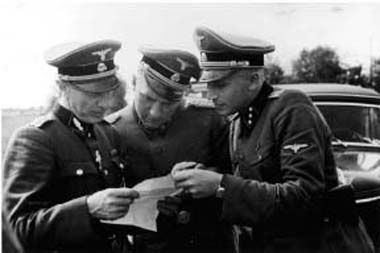
146.Three SS officers study a document during the dedication of the new SS hospital. Pictured left to right are Dr Enno Lolling, Commandant Richard Baer and Adjutant Karl Hocker. [Courtesy of USHMM ARCHIVES]

147. SS officers including Rudolf Höss watch as Commandant Baer exchanges documents with Karl Bischoff during the dedication of the new SS hospital in Auschwitz. [Courtesy of USHMM ARCHIVES]
The first transport of Hungarian Jews, consisting of 1,800 people, had arrived in Birkenau in early May, but Höss was expecting many more convoys over the ensuing weeks to come. In preparation for their arrival he immediately set to work and ordered that Crematorium V be put into operation again. An engineer’s report, however, confirmed that Crematorium V furnaces were still damaged, and because of their slow incineration rate they had replaced them in late April by five small incineration ditches. In order to compensate the huge numbers of transports expected over the coming weeks it was suggested to reactivate Bunker II, and designate it as Bunker 2/V. Höss agreed, because from his past experiences at the camp it was not actually the process of killing the Jews that presented him and his SS colleagues with any problems; the hardest task was disposing of the gassed victims. So that he could facilitate the process of murder quickly and effectively he made SS-Hauptsturmführer Otto Moll in charge of all four crematoria, and assigned a special squad to enlarge the inside of the crematoria. From Crematorium V a special track was laid between the building and the pits so that the corpses could be loaded onto trolleys and disposed of quickly. As for the other killing installations, they were also overhauled including Crematoria II and III, which received new elevators connecting the gas chambers with the incineration rooms. Even the walls of the changing rooms and the gas chambers were given a fresh coat of paint.
148. SS officers gather for the dedication ceremonies of the new SS hospital. Pictured in the centre is Commandant Richard Baer. From November 1942 until May 1944, Baer was adjutant of SS-Obergruppenführer Oswald Pohl, then chief of the Wirtschaftsverwaltungshauptamt (SS office of economic policy). In November 1943, he took over command of department D I, the Inspectorate for Concentration Camps. He succeeded Arthur Liebehenschel, considered by Himmler to be too soft with the prisoners, as the third and final commandant of Auschwitz from 11 May 1944, until early 1945. [Courtesy of USHMM ARCHIVES]
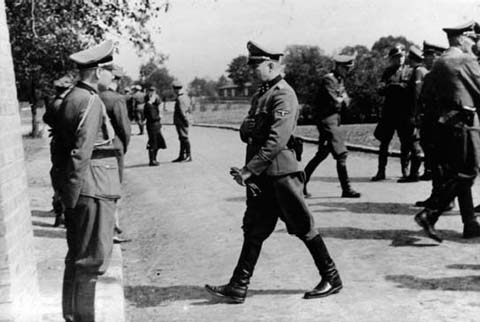
149. Guards stand at attention during the dedication of the new SS hospital in Auschwitz. [Courtesy of USHMM ARCHIVES]

150. SS officers and SS physicians arrive for the dedication of the new SS hospital at Auschwitz. [Courtesy of USHMM ARCHIVES]
To assist the smooth arrival of the Hungarian Jews and to provide a direct link between the Auschwitz station and the crematoria the train lines were extended through the main entrance of Birkenau with plans to run them right up to Crematoria II and III. Night and day hundreds of prisoners had been busy laying the three-way railway track through the camp, and constructing the loading and unloading ramps. By the second week of May the railway line was completed and the finishing touches were made to the ramps. From these ramps Höss would now coordinate the destruction of the Hungarian Jews, now code-named ‘Aktion Höss’.
The first major Hungarian transports steamed their way through to Auschwitz on 15 May. Once they arrived the train pulled over the new spur through the gate into Birkenau and halted at the ramps. Here at the ramps ‘Aktion Höss’ was put into operation, firstly unloading of the Jews from the cattle trains. Once the Jews were unloaded they were immediately separated into two columns, one of women and children, the other of men. A selection was then carried out by one or two SS medical doctors and the two columns were divided into four columns; two of women and children, and two of men.Those unfit for labour were sent straight ahead toward the crematoria, whilst all able-bodied workers were interned in Auschwitz, or were retained ready at a moment’s notice to be transferred to other camps in the Reich. The selection for labour in each transport varied daily, sometimes it was as low as ten per cent, or as high as fifty per cent. But the majority of Jews that arrived through the gates of Birkenau were immediately sent through to the ‘bathhouses’ to their death. Roughly there were 3,300 people per day arriving, sometimes that figure even rose to 4,300. On 20 May, for instance, one convoy arrived with an average of 3,000 people of whom some 1,000 were able, and 2,000 were unable to work. The following day on 21 May two convoys were reported to have arrived from Hungary with 6,000 people of whom 2,000 were able to work and the remainder were directly sent to their death. During that day both the incinerators of Crematoria II and III were being serviced so the victims from the transport were disposed of in the three incineration ditches next to Crematorium V.Though the specially built track from the crematorium to the pits had been laid it was never used because it was considered an inconvenience. Instead, the Sonderkommando had to drag the corpses directly from the gas chamber to the pits.
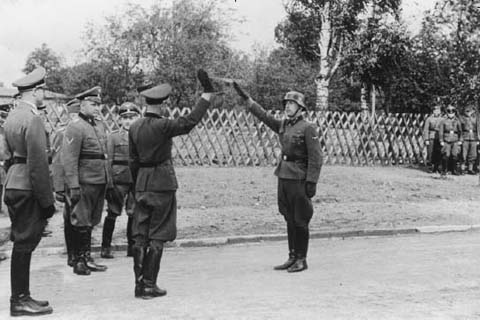
151. A soldier salutes an officer, while several other officers stand in the background during the dedication of a new SS hospital in Auschwitz. Pictured on the left are Dr Eduard Wirths, Commandant Richard Baer and Karl Bischoff. [Courtesy of USHMM ARCHIVES]
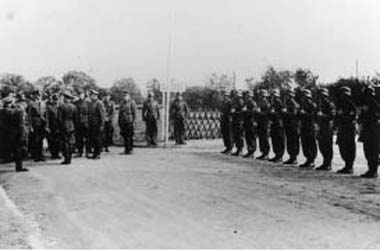
152. SS guards and officers, including Hocker and Höss, during the dedication of the new SS hospital in Auschwitz. [Courtesy of USHMM ARCHIVES]
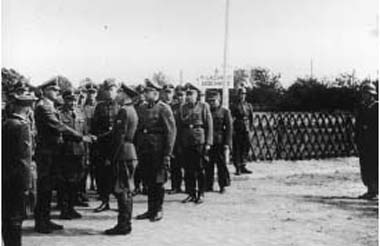
153. Dr Lolling shakes hands with Dr Eduard Wirths during the dedication of the new SS hospital in Auschwitz.The ceremony marks the transfer of documents and authority from the construction department to the camp upon completion of the project. [Courtesy of USHMM ARCHIVES]
As more convoys arrived daily at Birkenau from Hungary Höss was kept continuously informed on its progress. Regularly he visited Birkenau where he watched the selections, and was even seen observing the burning of the corpses in the open-air ditches, ensuring that they were being disposed of quickly, ready for the next arrival. The transports varied daily, but from the very beginning of the ‘Aktion’ until midnight on 28 May, it had been reported that some 184,049 Jews had arrived in Auschwitz in fifty-eight trains. Within a period of just two weeks approximately 122,700 persons that were deemed unsuitable for forced labour were subsequently sent to their death. Birkenau was effectively gassing over 8,000 Jews on average each day. For the Auschwitz authorities the numbers were no less impressive for it was the most sustained mass killing so far in the history of the camp, and only comparable to the scale of murders undertaken at Treblinka during July and August 1942.
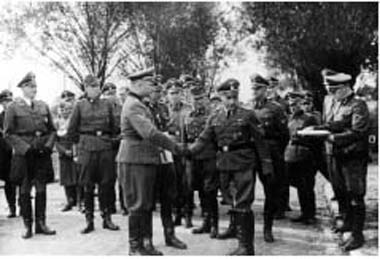
154. Officers watch Commandant Richard Baer shake hands [probably with Karl Bischoff] during the dedication of the new SS hospital in Auschwitz. [Courtesy of USHMM ARCHIVES]
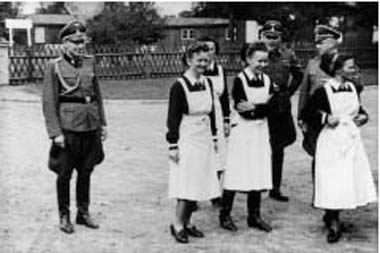
155. SS officers and German nurses gather during the dedication ceremony of the new SS hospital. Among those pictured are Karl Hocker, Josef Kramer and Heinrich Schwarz. In late 1943 early 1944, Schwarz became camp commandant of Auschwitz III Monowitz. While camp commandants at other camps in the complex were removed after only a few months, Schwarz continued to enjoy his superior Oswald Pohl’s goodwill. [Courtesy of USHMM ARCHIVES]
In order to ensure that the camp would not generate into chaotic disorder the SS increased the numbers of Sonderkommando that were working in shifts in the four crematoria. By the end of May there were nearly 900 of these people living and working in the crematoria.The whole of this horrific operation was supervised only by a handful of SS men.
Throughout June more trains continued to arrive from Hungary. Though the operation was a success, the high numbers gassed began to exceed the official incineration capacity, and as a result the crematoria begun overflowing with the dead. Many victims were already being burned in the pits nearby to cope with the high amount of corpses, but Moll, who oversaw the liquidation of the Hungarian Jews, assured his superiors that the ‘Moll Plan’ would be achieved swiftly and successfully.
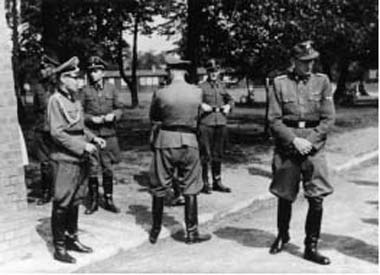
156. SS officers gather for the dedication ceremonies of the new SS hospital. Pictured on the left is Karl Hocker [Courtesy of USHMM ARCHIVES]
Over the coming weeks an orgy of destruction escalated.Thousands of Hungarian Jews continued their one-way passage to the crematoria, including valuable labour. Höss had observed how families had often fought to stay together during the selections, and watched with fascination how children clung to their mothers, screaming and crying. Instead of wrenching children from their mother’s arms he had learnt that the best way to prevent any emotional disturbances was to reluctantly send young and healthy women suitable for hard labour to the gas chambers with their offspring. Many Hungarian women and children went to their deaths in this way.

157. Officers walk towards the dedication of the new SS hospital in Auschwitz. In the centre to the right of Karl Hocker is the former commandant of Auschwitz, Rudolf Höss. [Courtesy of USHMM ARCHIVES]
158. SS officers and German nurses attend the dedication ceremony of the new SS hospital. Among those pictured is Karl Hocker (back, left). [Courtesy of USHMM ARCHIVES]
159.A photograph taken at Auschwitz after the handing over of the new SS hospital. Pictured left to right are Dr Eduard Wirths, Dr Enno Lölling, and Auschwitz commandant Richard Baer. Standing to their left is adjutant Karl Hoecker, and Rudolf Höss. [Courtesy of USHMM ARCHIVES]
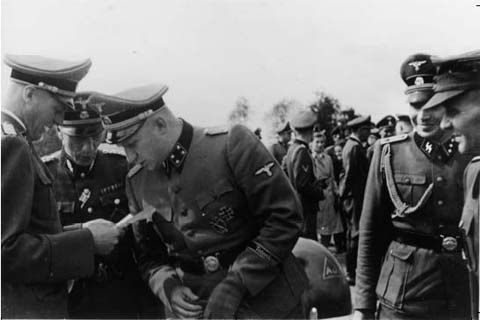
160. Another photograph taken at Auschwitz after the handing over of the new SS hospital. Pictured left to right Dr Eduard Wirths, Dr Enno Lölling, Commandant Richard Baer, Adjutant Karl Hoecker and Rudolf Hss. [Courtesy of USHMM ARCHIVES]
No matter how gruesome the outcome was for these hapless Hungarian Jews during the summer of 1944, the SS had created the perfect killing factory on an industrial scale. All four crematoria were now working more or less on a daily basis, killing thousands each day. The ovens continued to work at full capacity and the incineration ditches were being used day and night.The frenetic gassings and burnings carried on for days and weeks regardless of the deteriorating military situation. During July an average of 3,500 each day were arriving at the ramps with more than three-quarters of the new arrivals being sent directly to the crematoria for ‘special treatment’.This phenomenal figure certainly demonstrated the SS efficiency to oversee ‘Aktion Höss’ with a fanatical determination. In no less than eight weeks they had masterminded the killing of more than 320,000 Hungarian Jews. During July Budapest confirmed that the deportations were to be suspended.
Auschwitz had finally evolved, and it was now left in the capable hands of the new commander to start making plans to liquidate whole sections of Birkenau. One particular section that had been discussed was the gypsy camp. At its peak there were estimated to be some 23,000 gypsy men and women in the camp. However, thanks to overcrowding combined with the lack of food and water, disease had quickly spread throughout the camp killing 20,000 of the 23,000 gypsies. Those remaining were rounded up on the night of 2 August and marched off to the crematoria and gassed.
Over the next few months the killings at Auschwitz continued, but as the fighting on the Eastern Front deteriorated and the Russians pushed ever deeper into Poland, the Auschwitz authorities were ordered to cease extermination operations across the Reich. At Birkenau the Sonderkommando had dismantled all the killing apparatus. The incineration ditches too had been cleared and levelled, and pits which had been filled with ash and crushed bones of murdered prisoners were emptied and covered with fresh turf and other plantation. Crematorium I in the main camp had been turned into an air raid shelter and the chimney and holes in the ceiling in which the Zyklon B was thrown in was removed. All the furnaces of Crematoria I, II, III and IV were dismantled and usable parts transported to other camps. On the night of 17 January some 58,000 prisoners were evacuated from Monowitz and the Auschwitz sub-camps, with about 20,000 coming from the Auschwitz-Birkenau camp alone.Very few were evacuated by train, with the majority of them being forced into the snow and marched in freezing night-time temperatures westward towards Germany. As they shuffled along the icy road behind them the night sky lit with flashes and the distant sounds of Russian gunfire rumbled across the horizon. Anyone including children that were unable to keep pace with the mass exodus was shot and their murdered corpses left at the roadside.The scenes were utterly terrible.
161. After the formal handing over the new SS hospital at Auschwitz Rudolf Höss, seen on the left, strolls with Commandant Baer. [Courtesy of USHMM ARCHIVES]
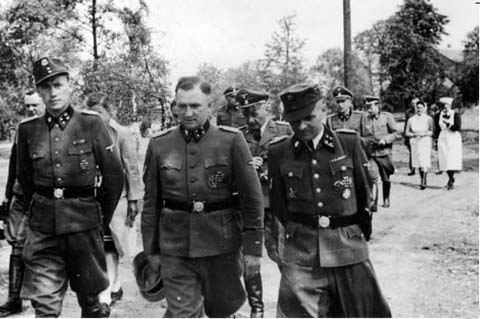
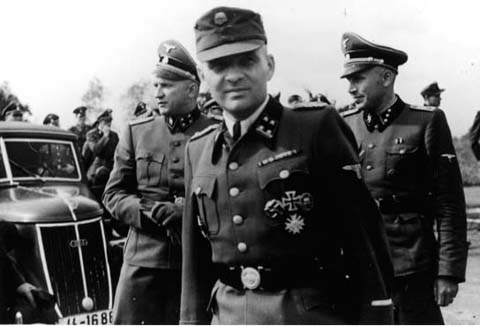
162.A well-decorated Rudolf Höss is pictured with Commandant Baer and Karl Hocker. [Courtesy of USHMM ARCHIVES]
162. Studio portraits of SS officers Richard Baer and Karl Hoecker.The original caption reads “With the Commandant SS Stubaf. Baer, Auschwitz 21.6.44”. [Courtesy of USHMM ARCHIVES]
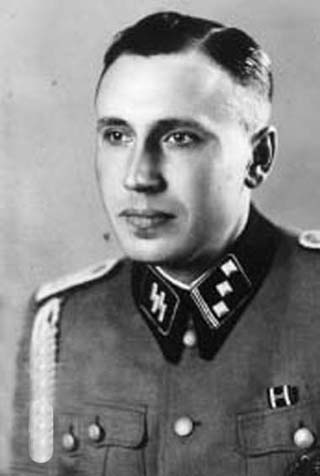
163. Studio portrait of Karl Hocker taken in June 1944. [Courtesy of USHMM ARCHIVES]
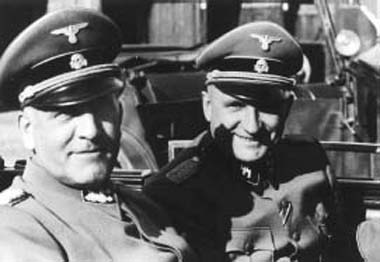
164. Commandant Richard Baer accompanies Oswald Pohl during an official visit to Auschwitz by automobile. [Courtesy of USHMM ARCHIVES]
165. SS officers relax and converse in groups on the grounds of the SS retreat at Solahutte, outside Auschwitz. From left to right: Josef Kramer, (unidentified), Karl Hocker, and Franz Hossler. Just weeks before this photograph was taken, in May 1944, Josef Kramer was put in charge of the gas chambers at the Auschwitz-Birkenau compound. He was to hold that position until December 1944, when he was transferred out as Commandant of Belsen. [Courtesy of USHMM ARCHIVES]
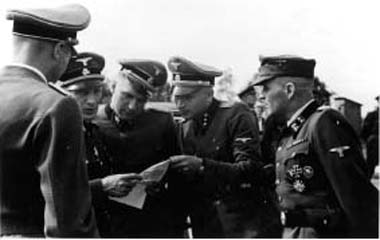
167. Several SS officers study a document during the dedication of the new SS hospital. Pictured left to right are Dr Enno Lolling, Commandant Richard Baer, adjutant Karl Hocker, andformer commandant Rudolf Höss.[Courtesy of USHMM ARCHIVES]
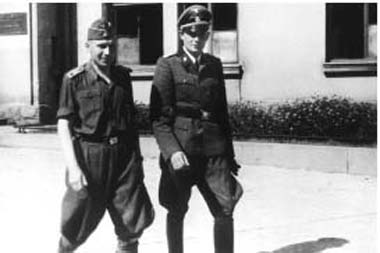
168.Two SS officers walk together past a building. Pictured on the left is Karl Hocker.The officer on the right is unidentified. [Courtesy of USHMM ARCHIVES]
169. SS officer Karl Hocker salutes in front of an array of wreaths during a military funeral at Auschwitz.The original caption of the photograph reads ‘Burying our SS comrades from a terror attack’. [Courtesy of USHMM ARCHIVES]
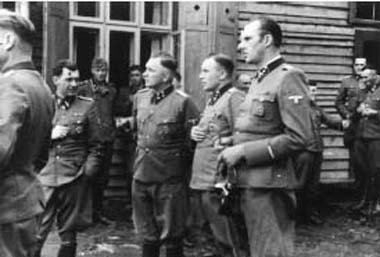
170. SS officers socialize at the SS retreat of Solahuette outside of Auschwitz. From left to right they are: Josef Mengele, Richard Baer (Commandant of Auschwitz), Karl Hocker (his adjutant) and Walter Schmidetzki (head of Canada and later Administrative Director of Monowitz).[Courtesy of USHMM ARCHIVES]
Amidst the chaotic evacuation order, the small groups of SS left behind at Auschwitz were given instructions for the demolition of the crematoria including Bunkers I and II. After having blown up the remaining shells of Crematoria II and III in the early afternoon of 20 January, six days later they dynamited Crematorium V. As for Crematorium IV, this building had been demolished after it had been damaged by fire following a revolt in October 1944 by Sonderkommando. During the demolition of the crematoria special SS units murdered around 700 prisoners at Birkenau and nearby sub-camps. As news of the Red Army advanced along the main road from Krakow, the guards were ordered to destroy the last of the camp records, set fire to the Canada stores and liquidate the remaining prisoners in the camp. However, more concerned with saving their own lives than following orders the SS guards fled the camp leaving the soldiers of the First Ukrainian Front to liberate Auschwitz and its sub-camps.
171. SS officers, some with cigars in hand, socialize on the grounds of the SS retreat Solahuette outside of Auschwitz. From left to right they are: Josef Kramer, Anton Thumann, Karl Hocker and Franz Hossler. Hoessler was commandant of the women’s camp in Auschwitz II (Birkenau).[Courtesy of USHMM ARCHIVES]
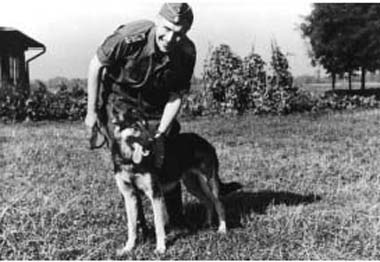
172.Time to relax from helping to instrument the last transports from Hungary, SS officer Karl Hocker takes his dog Favorit out on one of its regular walks outside the Auschwitz camp. [Courtesy of USHMM ARCHIVES]

173. Pictured on the far left is Josef Kramer (back to camera) and Dr Josef Mengele, Commandant Richard Baer and his adjutant Karl Hocker. Mengele went on to become the most highly decorated SS officer at Auschwitz to win the Iron Cross 1st Class. He had originally volunteered to come to Auschwitz in order to establish an experimental physiological and pathologicaldepartment in the camp. He hadn’t been in the camp very long before his sinister and merciless nature came to light. [Courtesy of USHMM ARCHIVES]
174. A group of SS officers stand in front of a building in Solahutte. Pictured facing the camera, second from the left is Karl Hocker. [Courtesy of USHMM ARCHIVES]
175. SS officers, including several SS physicians sit around a table drinking. Among those pictured are Karl Hocker (far left), Dr Fritz Klein (left hand side, end table), Dr Horst Schumann and Eduard Wirths on the right side of the bench, third from front. [Courtesy of USHMM ARCHIVES]

176.Two SS officers meet during the dedication of the new SS hospital in Auschwitz. Pictured on the left is Dr Enno Lolling and on the right is Dr Eduard Wirths. From September 1942 to January 1945,Wirth was the Chief SS doctor (SS-Standortarzt) at Auschwitz. He had formal responsibility for everything undertaken by the SS doctors (including Josef Mengele, Horst Schumann and Carl Clauberg) who worked in the medical sections of Auschwitz between 1942-1945. [Courtesy of USHMM ARCHIVES]
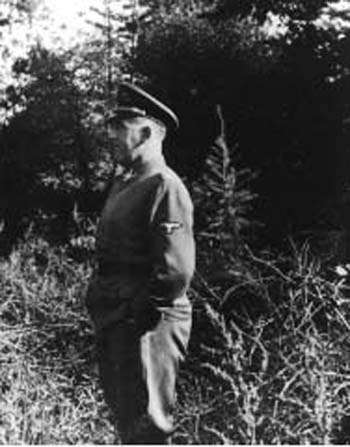
178. SS officer Oswald Pohl pays an official visit to Auschwitz. From the very start of its inception Pohl intended that Auschwitz would play a fundamental role in the concentration camp system in Upper Silesia and had high expectations of future economic success. [Courtesy of USHMM ARCHIVES]
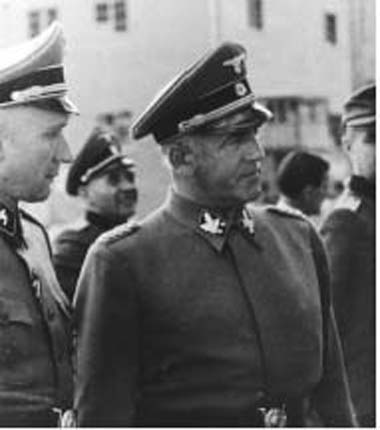
179. SS officer Oswald Pohl pays an official visit to Auschwitz accompanied by Auschwitz Commandant Richard Baer who had previously served as his adjutant. [Courtesy of USHMM ARCHIVES]
180. Photograph taken in the summer of 1944 showing from left to right Richard Baer, Dr Josef Mengele, Josef Kramer, Rudolf Höss and an unidentified officer. [Courtesy of USHMM ARCHIVES]

181. During the summer of 1944 SS officers socialize at the SS retreat at Solahuette, near Auschwitz. From left to right Rudolf Höss, Josef Kramer, and an unidentified officer [Courtesy of USHMM ARCHIVES]
182. Richard Baer, Dr Josef Mengele, and Rudolf Höss relax at the SS retreat at Solahuette during the summer of 1944. [Courtesy of USHMM ARCHIVES]
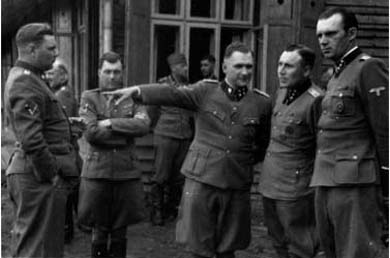
183. A group of SS officers gather in front of a building at Solahuette, the SS retreat outside of Auschwitz. From left to right are Josef Kramer, Dr Josef Mengele, Richard Baer, Karl Hocker and Walter Schmidetzki. [Courtesy ofUSHMM ARCHIVES]
184. At Auschwitz the SS held a number of comradeship meetings in order to try and encourage a sense of solidarity among the men. Although Höss had always found this type of solidarity a charade he nonetheless attended whenever he had time. Here in this photograph SS men sing along to the tune of an accordion at the SS retreat at Solahuette in the summer of 1944. Pictured in the front row are Karl Hoecker, Otto Moll, Rudolf Höss, Richard Baer, Josef Kramer (standing slightly behind Franz Hössler and partially obscured), Franz Hössler, and Josef Mengele. [Courtesy of USHMM ARCHIVES]
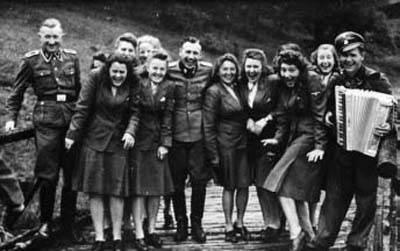
187. 188. 189.Three photographs showing SS officers gathering for shooting practise. On the far left is Karl Hocker [Courtesy of USHMM ARCHIVES]
190.190a.Two photographs taken by a Russian photographic unit showing children that have survived Auschwitz. By their physical condition it is more than probable that they have not been in the camp very long. In one of the photographs they are asked to reveal their numbers tattooed on their left arm. [Courtesy of the Auschwitz-Birkenau Museum/USHMM - Yad Vashem Museum]
191.Two Russian soldiers help two women and a teenage boy through the quagmire of Birkenau during its liberation. On the afternoon of Saturday 27 January 1945, soldiers of the 60th Army of the First Ukrainian Front liberated Auschwitz. In total some 5,800 weak and undernourished prisoners in Birkenau were liberated. [Courtesy of the Auschwitz-Birkenau Museum]
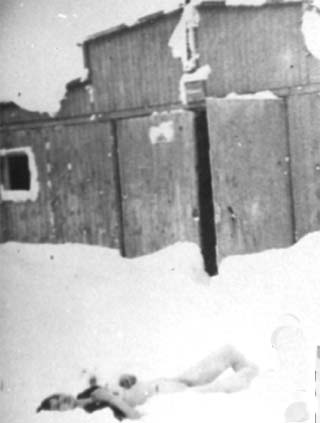
192.Taken after the liberation of Auschwitz the photograph shows a half-naked dead women lying in the snow in January 1945. It is more than probable that she was one of many that were murdered prior to the evacuation of the camp. [Courtesy of the Auschwitz-Birkenau Museum]
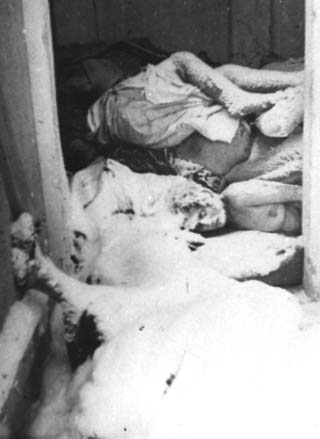
193. Piles of corpses inside the entrance of a wooden building after the liberation of the camp. On the night of 17 January 1945, some 58,000 prisoners were evacuated from Monowitz and the Auschwitz sub-camps; about 20,000 prisoners were evacuated from the Auschwitz-Birkenau camp alone. Special SS units that were left behind then proceeded to murder approximately 700 prisoners at Birkenau and nearby sub-camps.When news arrived that the Red Army were advancing along the main road from Krakow, the guards were ordered to destroy the remaining camp records, set fire to the Canada stores and exterminate the remaining prisoners. [Courtesy of the Auschwitz-Birkenau Museum]
194. A cart full of corpses more than likely destined for either one of the crematoria or open air burning pits. [Courtesy of the Auschwitz-Birkenau Museum]
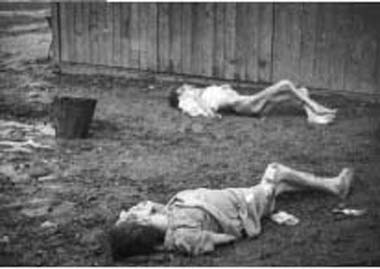
195. Half-naked malnourished corpses lay in the mud near one of the wooden barracks.They have been more than likely murdered by the SS prior to the evacuation of the camp in January 1945. [Courtesy of the Auschwitz-Birkenau Museum]
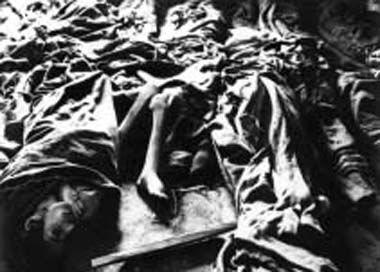
196. Many corpses have been found by Red Army troops still lying with blankets wrapped around their emaciated bodies. These hapless people have more than likely died of either malnutrition or disease. It’s a grim reminder of what horror the Russian soldiers witnessed when they entered Auschwitz in January 1945. [Courtesy of the Auschwitz-Birkenau Museum]
197. Inmates well enough to sit up pose for the camera inside the Auschwitz hospital in January or February 1945. [Courtesy of the Auschwitz-Birkenau Museum]
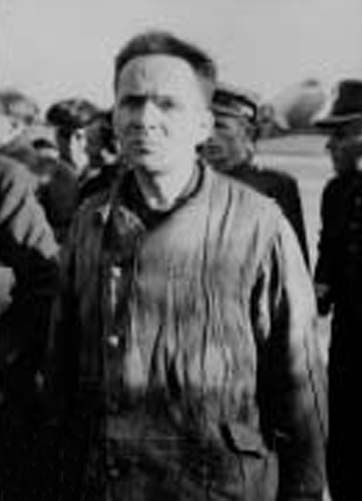
198. On 25 May 1946, the former commandant of Auschwitz-Birkenau, Rudolf Höss, was finally handed over to the Polish authorities to face charges of war crimes against humanity. His trial started on 11 March 1947 lasting until 29 March 1947. He was found guilty of the murder of more than 2.5 million people at Auschwitz-Birkenau camp. However, this figure was later proven to be grossly inaccurate. [Courtesy of the Auschwitz- Birkenau Museum]
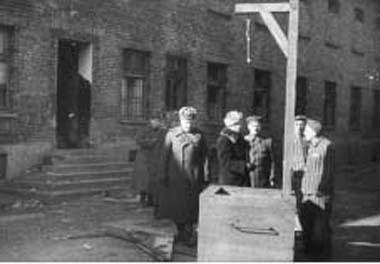
199.A Red Army officer converses with three Auschwitz prisoners standing next to a gibbet that was used frequently in Auschwitz. I to hang prisoners. [Courtesy of the Auschwitz-Birkenau Museum]
200.201.Two photographs showing the infamous railway line leading through the main gate of Birkenau. Completion of the railway line into the death camp was completed in the first half of May 1944, and used primarily for the transportation of Hungarian Jews to the camp. [Courtesy of the HITM ARCHIVE&Auschwitz-Birkenau Museum]
201b. From the main SS sentry observation post looking down the railway line to where Crematoria II (left) and Crematoria III (right) once stood. Right of the photograph is the area designated as B11, whilst to the left is the area known once as B1. [Courtesy of the HITMARCHIVE & Auschwitz-Birkenau Museum]
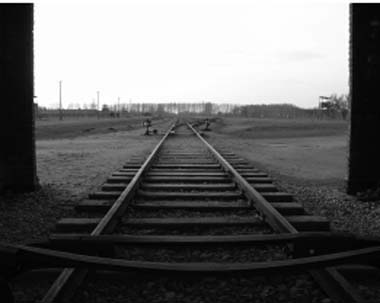
201a. A photograph taken from the main entrance to the Auschwitz-Birkenau site. [Courtesy of the HITM ARCHIVE & Auschwitz-Birkenau Museum]
201c. From the main SS sentry observation post looking across to the left at Women’s camp, designated as B1.a. [Courtesy of the HITM ARCHIVE & Auschwitz-Birkenau Museum]
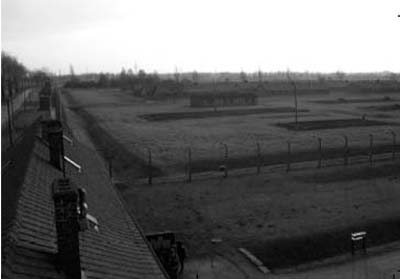
202. From outside the main perimeter on the right is a barbed wire fence, and beyond that is a large area designated as BII-a,b,c,d,e, and f, which contained the Quarantine camp, Family camp for Theresienstadt Jews, camp for Hungarian Jews, Men’s camp, Gypsy camp, and prisoner hospital area. [Courtesy of the HITM ARCHIVE & Auschwitz-Birkenau Museum]
203. A photograph taken from outside the main perimeter of Auschwitz-Birkenau in 2007 showing the outer camp fence and the wooden block stable barracks in the designated area known as BII. [Courtesy of the HITM ARCHIVE & Auschwitz-Birkenau Museum]
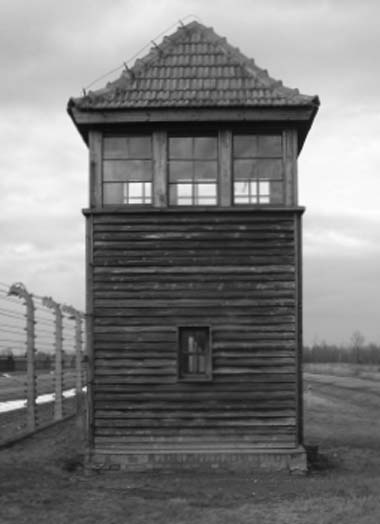
204. One of Auschwitz-Birkenau’s prefabricated wooden guard towers along the perimeter fence of BII. [Courtesy of the HITM ARCHIVE & Auschwitz-Birkenau Museum]
205. A number of intact horse stable barracks at Auschwitz-Birkenau in BIIa, which was the designated area for the Quarantine camp. Note the drainage ditches. [Courtesy of the HITM ARCHIVE & Auschwitz-Birkenau Museum]
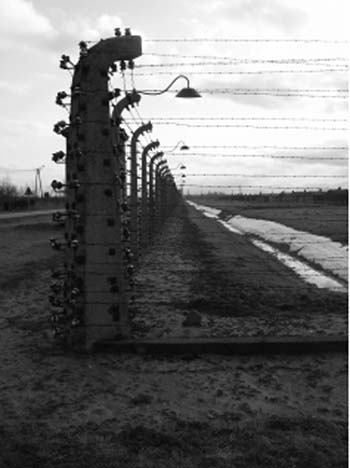
206.A photograph taken on the corner of the outer perimeter fence of BII-a looking down towards the camp’s main entrance. [Courtesy of the HITM ARCHIVE & Auschwitz-Birkenau Museum]
207.The entrance to into the BII area of the camp. On the left was the former camp for Hungarian Jews, whilst on the right was the Men’s camp. All the buildings in this area were blown-up by the SS when they evacuated the camp leaving just parts of the brick structure and chimney stacks intact. [Courtesy of the HITM ARCHIVE & Auschwitz-Birkenau Museum]
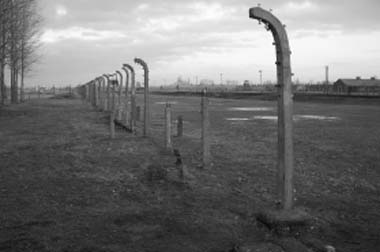
208. Showing part of the perimeter fence that separated the railway line and the area designated for Crematorium II.The brick buildings in the distance was in an area known as B1- b, which was part of the Women’s camp. [Courtesy of the HITM ARCHIVE & Auschwitz-Birkenau Museum]
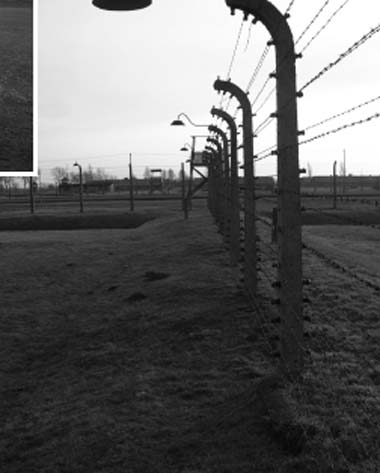
209.A photograph taken from inside B11 looking across the camp’s railway line to an area known as B1-a, which was part of the Women’s camp. [Courtesy of the HITM ARCHIVE & Auschwitz-Birkenau Museum]
210. From the railway line the photograph shows part of the B1-b Women’s camp with intact red brick barracks.The road between the railway line and the perimeter fence of the Women’s camp led to Crematoria II and III. [Courtesy of the HITM ARCHIVE & Auschwitz-Birkenau Museum]
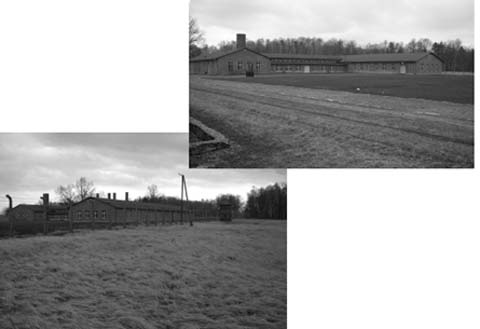
211.212.Two photographs showing the building known as the Central Sauna, which was completed by the autumn of 1943. It entered service in December 1943 and functioned as a disinfestation facility until January 1945.The building was situated at the far end of the camp behind the storage barracks of Canada. [Courtesy of the HITM ARCHIVE & Auschwitz-Birkenau Museum]
213.The camp’s former water treatment facilities.This structure was situated between Crematorium III and the Canada storage facility at the far end of the camp. [Courtesy of the HITM ARCHIVE & Auschwitz-Birkenau Museum]

214. Concrete stairs leading down to the undressing chamber of Crematorium III. It was here where thousands of Jews descended these steps to undress prior to being gassed. [Courtesy of the HITM ARCHIVE & Auschwitz-Birkenau Museum]
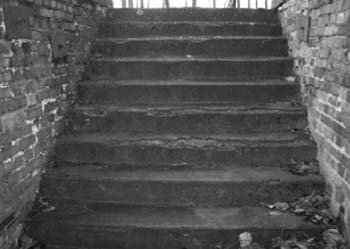
215. Another view of the stairs leading down to the undressing chamber of Crematorium III.The undressing chamber measured 25ft in width and 169ft in length. A roof once covered the undressing chamber. [Courtesy of the HITM ARCHIVE & Auschwitz-Birkenau Museum]
216. Inside the undressing chamber of Crematorium III.The rubble is all that is left of the chamber’s roof. [Courtesy of the HITM ARCHIVE & Auschwitz-Birkenau Museum]
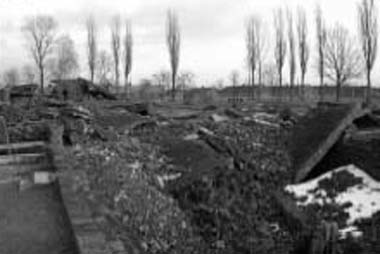
217.The remains of Crematorium II.[Courtesy of the HITM ARCHIVE & Auschwitz-Birkenau Museum]
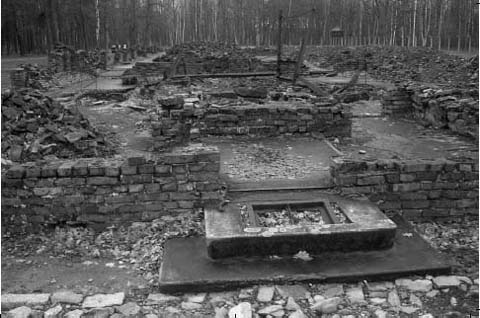
218.The remains of Crematorium V. According to a Czech prisoner the SS dynamited Crematorium V, which exploded about one o’clock in the morning on 26 January 1945, just twenty-four hours before the Red Army arrived. [Courtesy of the HITM ARCHIVE & Auschwitz-Birkenau Museum]
221. A typical red brick barracks inside the Women’s camp B1-b. [Courtesy of the HITM ARCHIVE & Auschwitz-Birkenau Museum]
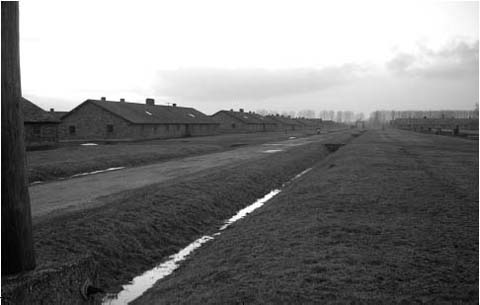
220. A photograph taken inside the Women’s camp designated as B1-a. [Courtesy of the HITM ARCHIVE & Auschwitz-Birkenau Museum]
223.This wooden building was used by the notorious Josef Mengele. As camp physician Mengele had a never-ending supply of human specimens on whom to experiment.Wearing his white doctor’s coat and gloves, he was usually present at the selection ramps in order to single out those unfit for work. Mengele was obsessed with genetics and the theory of a Nazi master race, and he availed of the selections to hand-pick victims for participation in his own sadistic medical trials. [Courtesy of the HITM ARCHIVE & Auschwitz-Birkenau Museum]
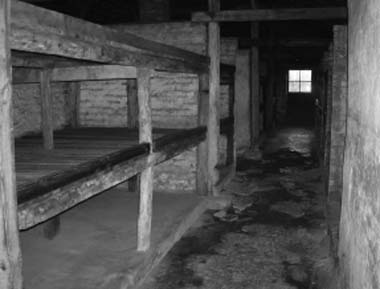
222.This is the inside of a building used for housing females in the Women’s camp and clearly shows three bed wooden bunk system. [Courtesy of the HITM ARCHIVE & Auschwitz-Birkenau Museum]
225. A wooden guard tower on the outside of the perimeter fence of the Women’s camp designated as B1-a. [Courtesy of Chandran Sivanason Aushwitz-Berkenau Museum]
226.The remains of the horse stable barracks in B11.The red brick chimneys and the flues are all that remain after the SS blew them up during the evacuation of the camp in January 1945. [Courtesy of Chandran Sivanason & Auschwitz-Birkenau Museum]
